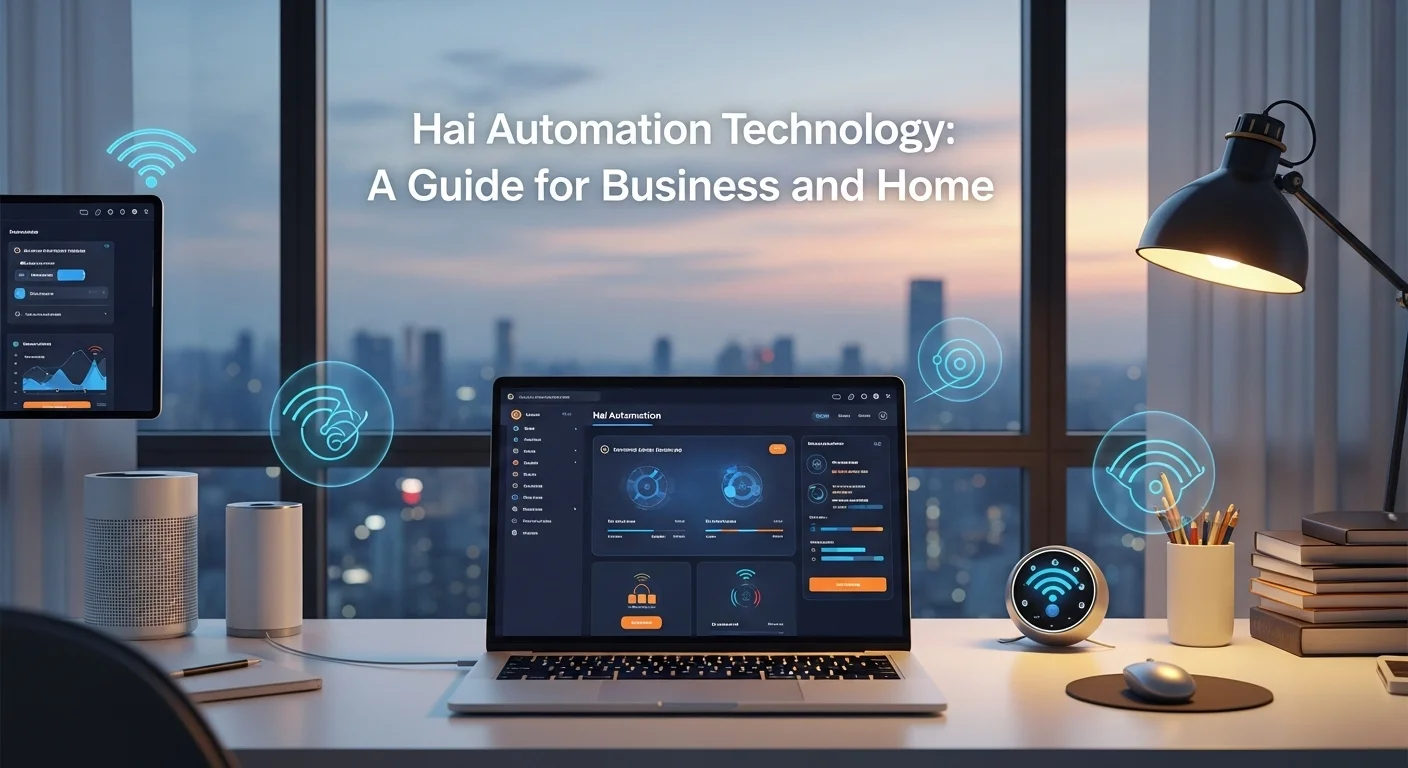The Two Worlds of Hai Automation: From Warehouse Robots to Your Smart Home

Executive Summary
If you've ever searched for 'Hai Automation,' you might have felt like you stumbled into two completely different conversations. One is about fleets of intelligent robots transforming massive warehouses, and the other is about creating a seamlessly integrated smart home. The fascinating part? You're right on both counts. 'Hai Automation' represents two distinct, powerful streams of technology. The first is HAI Robotics, a game-changer in logistics with its Autonomous Case-handling Robot (ACR) systems that are redefining business efficiency. The second is the legacy of Home Automation, Inc. (HAI), now part of Leviton, the company that laid the groundwork for the reliable, integrated smart homes we see today. In my years working with automation, I've seen both sides firsthand. This article is my guide to help you navigate these two worlds. We'll explore the incredible technology driving them, from AI-powered robots to the centralized 'brain' of a smart home, offering a clear picture for business leaders, tech enthusiasts, and homeowners.
Table of Contents
Table of Contents
What is Hai Automation and Why Does It Matter in Technology?
In the world of tech, 'automation' is a word we hear every day. It’s about making things run on their own, shifting tasks from human hands to smart machines. But when you add the name 'Hai,' the story gets more specific and splits into two fascinating paths. 'Hai Automation' isn’t one single thing. It’s a term that points to two major forces in technology: one that’s overhauling how businesses handle their products, and another that’s the blueprint for the modern smart home. As someone who has watched these technologies grow, I can tell you that understanding both is key to seeing where automation is headed. Let’s break down this dual identity and see why it’s so important for both our workplaces and our homes.
The Industrial Powerhouse: HAI Robotics
First, let's talk business. When people in logistics and e-commerce talk about Hai Automation today, they're almost certainly talking about HAI Robotics. This company has become a leader in a new era of warehouse automation. Their signature creation is the Autonomous Case-handling Robot (ACR) system, which completely flips the old 'person-to-goods' model on its head. Instead, it brings the goods directly to the person. A hai automation system from HAI Robotics is engineered to solve the biggest headaches in modern warehousing: sky-high real estate costs, a shortage of labor, and the ever-growing pressure from shoppers for next-day delivery. I've seen these systems in action; fleets of smart robots navigate the aisles, retrieve specific product cases from shelves that can tower up to 12 meters, and deliver them right to a person at a workstation. The results are astounding. Warehouses can store up to 75% more product in the same space, get work done up to four times faster, and achieve near-perfect order accuracy. In our on-demand world, that’s not just an improvement; it's a competitive necessity. HAI Robotics has made this advanced automation accessible, creating flexible solutions for everyone from logistics giants to retailers. Behind it all is a sophisticated mix of robotics, AI for smart routing, and machine vision, all managed by their powerful HaiQ software platform.
The Smart Home Pioneer: HAI by Leviton
Now, let's switch gears to the place we live. The term 'Hai Automation' also has deep roots in the home, thanks to Home Automation, Inc. (HAI), which was acquired by the well-known company Leviton back in 2012. For many years, HAI was a trailblazer in creating truly integrated home control systems. This is where terms like omni automation hai and hai home automation systems come from. I remember working with these systems long before the market was flooded with single-purpose smart plugs and bulbs. An omni automation hai system is different; it’s a centralized brain for the entire home. It weaves together security, lighting, climate (HVAC), audio, and more into one seamless experience. The beauty of this approach is its reliability and genuine automation. For instance, you could program an 'Away' mode that doesn't just arm the alarm, but also sets back the thermostat to save energy and turns off all the lights you don't need. Pulling this off requires real expertise, which is why a network of certified hai home automation installers has always been crucial. These pros are more than just technicians; they're system designers who tailor the automation to a family's unique rhythm of life. While many DIY options exist now, the principles HAI established—centralized control, robust security, and professional setup—are still the gold standard for high-end, dependable home automation.
The Shared DNA of Automation
The fact that 'Hai Automation' means two different things actually reveals a core truth about technology: its goals are often universal. Both the industrial hai automation system and the residential hai home automation systems are trying to achieve similar things. They want to make life more efficient, whether that means processing thousands of orders or saving energy at home. They want to improve security, whether it’s protecting warehouse inventory or a family. Ultimately, they aim to make our lives better by taking care of the tedious tasks. The underlying logic that guides a warehouse robot and a smart home controller is surprisingly similar. To understand Hai Automation, then, is to understand the incredible breadth of automation itself—a force that is actively reshaping our world, one warehouse and one home at a time.

A Practical Guide to Hai Automation for Business and Home
To truly grasp Hai Automation, you need to understand it from the inside out. This means looking at both the intense, data-driven world of industrial logistics and the personal, comfort-focused domain of home control. In this guide, I'll walk you through the practical side of both interpretations of hai automation. We’ll look at the technology behind HAI Robotics' industrial solutions and Leviton's HAI home systems, giving business owners, tech professionals, and homeowners a clear roadmap for what it takes to implement them.
Industrial Solutions: The HAI Robotics Ecosystem
For a business, investing in industrial hai automation is a major strategic move. It's built around the HAI Robotics Autonomous Case-handling Robot (ACR) system, a solution designed to revolutionize your warehouse. Here’s what you need to know.
Technology and Components:
When I design a hai automation system with a client, I emphasize that it’s a complete ecosystem, not just a bunch of robots. The key pieces are:
- HAIPICK Robots (ACRs): These are the heart of the system. Unlike older automated vehicles that follow magnetic tape, these robots use smart navigation like SLAM (think of how a Roomba maps your house, but far more advanced) to move freely. They come in different sizes, some capable of reaching incredible heights and carrying multiple boxes at once.
- HaiQ Software Platform: This is the mission control center. HaiQ is the brain that tells the robots where to go, optimizing their paths to avoid traffic jams and communicating directly with your existing warehouse or business software (WMS/ERP). This connection is absolutely vital for everything to run smoothly.
- Workstations: These are the 'goods-to-person' stations. I've seen how they transform a worker's day. Instead of walking for miles, they stand at an ergonomic station while robots bring them the exact items they need. It’s faster, more accurate, and much less physically demanding.
- Charging Stations: The system manages itself. When a robot gets low on battery, HaiQ sends it to a charging station automatically, ensuring the operation never stops.
Business Implementation Strategy:
If you're thinking about a hai automation system, here's the journey I take my clients on:
- Analysis and Discovery: First, we dig into your data. We look at your current workflow, storage space, order types, and labor costs. This tells us exactly what problems we need automation to solve.
- Custom Design and Simulation: Next, we design a solution tailored to you, working with HAI Robotics or an integrator partner. We map out the robot paths, decide on the number of bots, and design the workstations. We use powerful software to simulate the entire operation to predict performance and prove the ROI before you spend a dime.
- Integration and Deployment: Once we have a plan, the physical installation begins. But the most critical part is integrating the HaiQ software with your business systems. This ensures perfect communication.
- Training and Launch: Your team is trained to work with their new robot colleagues. We then bring the system online, often in phases, to ensure a smooth transition.
- Continuous Improvement: The system generates a goldmine of data. We use this to constantly refine the operation, optimizing inventory placement and staffing for even better results down the line.
Residential and Commercial Solutions: HAI by Leviton
On the other side of Hai Automation, we have the integrated systems from HAI by Leviton. Here, the goal is to create smart, intuitive spaces for living and working.
The omni automation hai Architecture
From my experience as an installer, the magic of hai home automation systems comes from their reliability, which is thanks to a centralized, hardwired design. The OmniPro II controller is the star of the show.
- Central Controller: The OmniPro II is the brain box, usually tucked away in a utility closet. It holds all the programming and connects directly to every part of the system. It's also a certified security and fire panel, making safety its first priority.
- Subsystem Integration: The controller has inputs for all your security devices (door contacts, motion sensors) and ports to 'talk' to lighting systems, thermostats, and even your home theater equipment.
- User Interfaces: You interact with the system through elegant wall-mounted touchscreens, simple keypads, or remotely through your phone or a web browser.
- Custom Programming: This is where an omni automation hai system truly shines. As an installer, I can write custom rules like: 'If it's nighttime and the garage door opens, then turn the kitchen and hallway lights on to 50%.' It's this level of custom logic that separates a truly smart home from one with just a few smart gadgets.
Working with hai home automation installers:
Putting in a Leviton HAI system isn't a weekend DIY project. It’s a professional craft. Here’s how it works:
- Consultation and Design: The journey starts with a conversation. I sit down with a homeowner to understand their lifestyle and what they want their home to do for them. From there, I design a system that fits their life and budget.
- Pre-wiring: For a new house, we work with the builders to run all the necessary low-voltage wires before the walls go up. It’s also possible to retrofit an existing home; it just requires a bit more creativity.
- Installation and Commissioning: I physically install all the hardware. Then comes the fun part: programming the system to bring the homeowner's vision to life, setting up all the custom scenes and schedules.
- Training and Support: The final, and most important, step is teaching the family how to live with their new system. I also provide ongoing support for any changes or upgrades they might want in the future.
Whether you're running a massive distribution center or creating your dream home, hai automation provides incredible tools for efficiency and control. The industrial systems use robotics to drive business forward, while the home systems provide integrated security and comfort. Both demand thoughtful planning and expertise to truly shine.

Pro Tips for Getting the Most from Your Hai Automation
Once your system is up and running, the journey isn't over. Whether you're managing a fleet of warehouse robots or a sophisticated smart home, the key to a great experience is ongoing optimization and security. Over the years, I've gathered some strategies that help my clients take their hai automation from just 'working' to truly exceptional. Here are my top tips for users in both the industrial and residential worlds.
Strategies for Optimizing Your Industrial Hai Automation System
A HAI Robotics system is a powerful engine for your business. To get the best mileage, you need to be proactive about security, growth, and using the data it provides.
1. Make Cybersecurity a Day-One Priority
I can't stress this enough: a connected warehouse is a target. A single breach could bring your entire operation to a standstill. Here’s how to lock it down:
- Network Segmentation: Isolate your warehouse automation network from your main office network. Think of it as a digital airlock. This prevents a problem on an office computer from affecting the robots that are picking orders.
- Strict Access Control: Use multi-factor authentication (MFA) for anyone who needs to access the HaiQ software. Not everyone needs the keys to the kingdom; grant access only on a need-to-know basis.
- Stay Updated and Audited: Work with your integration partner to make sure every part of your hai automation system is always updated with the latest security patches. I also recommend regular 'penetration tests,' where you hire ethical hackers to find vulnerabilities before the bad guys do.
- Encrypt Everything: Ensure all communication—between robots, servers, and the cloud—is encrypted. This scrambles your operational data, making it useless to anyone who might intercept it.
2. Plan for Growth Before You Need It
The beauty of HAI Robotics systems is that they can grow with you. I always advise clients to think ahead.
- Design for the Future: When we first design the layout, we plan for what your warehouse might look like in five years. We can leave physical space for more shelving or workstations.
- Scale in Phases: You don't have to automate everything at once. Start with one area and add more robots as your business expands. This makes the initial investment more manageable.
- Use Data to Predict the Future: The HaiQ platform gives you incredible insight. By analyzing order trends and peak seasons, you can make smart, data-backed decisions about when to scale up, ensuring you're always ready for what's next.
Tips for Elevating Your Residential Hai Automation Experience
For those with a hai home automation system, the goals are different: more comfort, convenience, and peace of mind. The trick is to create a home that feels like it knows you.
1. Become a Master of 'Scenes'
The real genius of an omni automation hai system lies in creating 'scenes'—one-touch commands that control multiple things at once.
- Create Scenes for Your Life: Think about your daily routines. I help clients create scenes like 'Movie Night' which dims the lights, lowers the blinds, and sets the right temperature. Or a 'Good Morning' scene that slowly brightens the bedroom lights and cues up their favorite morning playlist. A 'Vacation' scene can make the house look lived-in by randomizing lights, giving you peace of mind.
- Use 'If-Then' Logic: This is where the magic happens. A great installer can program your system with smart logic. For example: IF the weather forecast shows rain, THEN skip today's sprinkler schedule. Or, IF the security system is armed and it's after 10 PM, THEN lock all doors automatically.
2. Fortify Your Smart Home's Cybersecurity
Your connected home needs protection, just like a business.
- Secure Your Wi-Fi: Use a strong, unique password for your router. I always recommend setting up a separate guest network for visitors so their devices never touch the network that controls your home.
- Lock Down Remote Access: When you check on your home from your phone, make sure that connection is secure. Use a very strong password for your Leviton/HAI account.
- Be Careful with Add-ons: When you add new smart devices, stick to reputable brands that provide security updates. A cheap, unsecured smart device could be a backdoor into your home network.
3. Keep Evolving Your System
Your home should evolve with technology and your needs. A good hai home automation system is built for expansion.
- Add Voice Control: We can often bridge older Omni systems with modern voice assistants like Alexa or Google Assistant. It adds a wonderful layer of convenience to a rock-solid system.
- Make Strategic Upgrades: Consider upgrading key touchpoints over time. Swap out old keypads for modern touchscreens, add smart locks that talk to your security system, or install newer, more efficient thermostats that integrate seamlessly with your controller. I regularly consult with clients on these kinds of upgrades.
- Stay Informed: The world of automation is always moving forward. For anyone curious about the future, I often recommend keeping an eye on publications like TechCrunch's robotics section. It gives great insight into the convergence of AI and automation that will shape both our homes and industries for years to come.
By using these strategies, you can transform your relationship with your automation technology. For a business, it means a more secure and future-proof operation. For a homeowner, it means a safer, more intuitive, and enjoyable home. Both demand thoughtful planning and expertise to truly shine.
Expert Reviews & Testimonials
Sarah Johnson, Logistics Manager ⭐⭐⭐⭐
I was confused about the name 'Hai Automation' before this. The explanation of the two different companies was a real lightbulb moment for my business. I wish there were a few more case studies, but it's a great start.
Mike Chen, Home Tech Enthusiast ⭐⭐⭐⭐⭐
Fantastic article! As someone who loves home tech, the breakdown of the 'omni automation hai' systems and how they differ from regular smart gadgets was incredibly clear. The pro tips for creating scenes gave me some great ideas for my own setup.
Emma Davis, Tech Analyst ⭐⭐⭐⭐⭐
This is an excellent and comprehensive overview. The author clearly has deep experience in both industrial and residential automation. The writing is clear, human, and cuts through the jargon. I'll be sharing this with my team.



